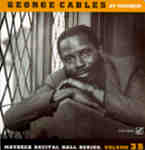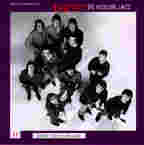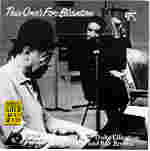Music Reviews
Jazz CD Music Reviews - Part 3 - February, 1997
By John Sunier
![]()
| Ratings: | ||
| Extraordinary | ||
| Good | ||
| Acceptable | ||
| Mediocre | ||
| Poor |
![]()
 |
MAYBECK RECITAL HALL SERIES | |||
| one of 35 volumes | ||||
| Concord Jazz | ||||
| Illustrated is "George Cables at Maybeck," Volume 35 in the series. | ||||
|
For dozens of the top jazz piano players in the country, a modest 50-seat hall in a residential area of Berkeley, California is their favorite place of all to play. There is good reason for their attraction to the Maybeck Recital Hall. Originally designed especially for a piano teacher by a famed architect specialist in handcrafted wooden homes, Bernard Maybeck, the redwood-lined space has clean live acoustics that neither muddy the piano sound with excessive reverb nor swallow it up. It thus becomes an ideal environment for all concerned -- the artist at the keyboard, the small and respectfully quiet audience and the recording engineer for this long series of CDs taped during live jazz recitals at the hall. I can testify to all three ideal situations, having attended several recitals, run up and down the keyboard of one of the two pianos, and taped an entire two-piano recital binaurally myself. The lineup of performers in the series is staggering, and the volumes keep coming out on a regular basis. If you want to hear the true talent of these jazz pianists without studio editing patchwork or sonic trickery, any of these CDs will give it to you in spades. Among the first lucky 35 have been: JoAnne Brackeen, Dave McKenna, Dick Hyman, Stanley Cowell, John Hicks, Marian McPartland, Kenny Barron, Roger Kellaway, Buddy Montgomery, Hank Jones, Jaki Byard, Richie Beirach, Jessica Williams, Ellis Larkins, Adam Makowicz, Cedar Walton, Denny Zeitlin, Ralph Sutton, Fred Hersch, Roland Hanna, and Kenny Werner. There is something almost magical about the effect of this hall on the players; even those few whose recent studio CDs might have been disappointing, shine brilliantly in their Maybeck spotlight. Try just one by your favorite pianist on the list and you'll be hooked to pick up more in the series!
John Sunier
![]()
 |
ONZTET DE VIOLON JAZZ (11-tet of Violin Jazz) | |||
| JMS 18623-2, Distributed by Sony Music, CD, 51:11 | ||||
|
This French multi-violin group draws inspiration from fellow French cats Stephane Grappelli and Jean-Luc Ponty. An all-violin ensemble isn't so unusual; there is even a multi-string-bass ensemble in Paris, but one so hip and swinging is unusual. There's no hint of a MOR-sensibility here! The massed string sound is rounded out with a rhythm section of keyboard, drums and string bass, and a number of guests are heard on various tracks. Among them is violinist Didier Lockwood, harmonicist Jean-Jacques Milteau and even three guitarists. The result is great variety among the dozen tracks. The opening "V11" starts things off with high energy, alternating unison statements by the violins with interesting part writing and solos for the piano as well as for Lockwood with his electric violin. "Lantou late" is a sparkling Latin jazz outing and "Tango" takes the ensemble to Argentina. Milteau's harp wails on a funky "Shuffle," and the closing heavily electric "String-time" boasts three solos - by two of the three guitarists and one of the violinists. Altogether this is very different from the anemic string quartet behind Charlie Parker on his innovative string sessions.
John Sunier
![]()
 |
THIS ONE'S FOR BLANTON | |||
| Duke Ellington, piano; Ray Brown, acoustic bass, Analogue Productions Gold CD Ltd. Edition, from Pablo/Fantasy original CAPJ 015, CD, 40 min. | ||||
|
Originally recorded in Las Vegas in l972, this unusual duo session was one of the gems of Norman Granz's Pablo LP series. Now it has been remastered by Doug Sax from the original tapes and transferred to premium gold CD to boot. The Pablo vinyls were very good, but the CD has greater extension in the basement and a more solid piano tone. Jimmy Blanton was a young bass-playing prodigy in Ellington's band in the early 40's who came up with the then-crazy idea that the string bass should play solos. His work changed forever the role of the bass in jazz, then he died of TB at the age of only 21. Brown and Ellington play on this album some of the same music Blanton had played with him in duo form during Ellington band appearances. The unadorned presentation puts a sonic magnifying glass on the amazing improvisations of these two towering giants of jazz. Five Ellington classics begin the set, including "Things Ain't What They Used to Be", and "Sophisticated Lady". Then to the four-movement "Fragmented Suite for Piano and Bass" -- a tour de force of musical collaboration. This CD may be a bit shy in length, but certainly not in creative or sonic achievement, and is well worth the premium price.
John Sunier
![]()
 |
DAVID MURRAY/JAMES NEWTON QUINTET | |||
| With John Hicks, Fred Hopkins, Andrew Cyrille & Billy Hart, D.I.W. 906 (Japanese Import), CD, 55:03 | ||||
|
This Japanese label has been consistently doing some of the best jazz on CD today, and David Murray is well-represented in their catalog. Combining one of the most exciting saxists in jazz today with probably the top jazz flutist and one of the piano greats (Hicks), it would be difficult not to succeed. The sessions were taped in New York in 1991 but just released. The seven tracks (some running as long as 12 minutes) are all credited to members of the quintet, with three by Newton and two by Murray among them. "Moon Over Sand II" and "Akhenaten" are lovely duets for Murray & Newton -- the first with bass clarinet and flute and the second with Murray switching to tenor sax. "Blues in the Pocket" is a light and tunefully swinging outing by Hicks for the entire quintet. Only "Muhammad Ali" delves into a free jazz blowing session, but Murray plays with such conviction and structure that even that is not as annoying to sensitive ears as the efforts of most loft jazz players.
John Sunier
![]()
© Copyright 1995, 1996, 1997
Secrets of Home Theater & High Fidelity
Return to Table of Contents for this Issue.

